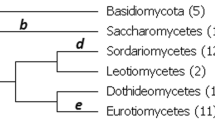Abstract
A relationship between the functional significance of individual amino acid residues of p53, their positions in the protein structure, and the mode of the evolution of the codons corresponding to these residues was established. A phylogenetic analysis of the coding sequences of the gene of p53 from 32 vertebrate species was performed. It was found that directional selection affects the codons influencing the efficiency of binding of p53 as a transcription factor to DNA. It was shown that, in conserved codons, the frequency of generative mutations maintaining the normal function of the protein statistically reliably differs from the frequency of mutations with the effects of loss and acquisition of function and the dominant negative effect. The phylogenetic analysis and molecular dynamics simulations also confirmed the functional significance of the residue G245, for which the formation of a Zn2+-binding site in the G245C substitution was previously assumed.
Similar content being viewed by others
References
T. Soussi, K. Dehouche, and C. Beroud, Hum. Mutat. 15, 105 (2000).
A. J. Levine, C. A. Finlay, and P. W. Hinds, Cell 116, S67 (2004).
S. N. Rodin and A. S. Rodin, Semin. Cancer. Biol. 15, 103 (2005).
G. S. Firestein, F. Echeverri, M. Yeo, et al., Proc. Natl. Acad. Sci. USA 94, 10895 (1997).
M. L. Smith, I. T. Chen, Q. M. Zhan, et al., Science 266, 1376 (1994).
M. B. Kastan, O. Onyekwere, D. Sidransky, et al., Cancer Res. 51, 6304 (1991).
S. W. Lowe, H. E. Ruley, T. Jacks, and D. E. Housman, Cell 74, 957 (1993).
E. Yonish-Rouach, D. Resnitzky, J. Lotem, et al., Nature 352, 345 (1991).
A. J. Levine, Cell 88, 323 (1997).
L. A. Donehower, Cancer. Sur. 29, 329 (1997).
F. Amariglio, F. Tchang, M. N. Prioleau, et al., Oncogene 15, 2191 (1997).
J. Prochazkova, V. Lichnovsky, D. Kylarova, et al., Gen. Physiol. Biophys. 23, 209 (2004).
J. B. Wallingford, D. W. Seufert, V. C. Virta, and P. D. Vize, Curr. Biol. 7, 747 (1997).
K. Takebayashi-Suzuki, J. Funami, D. Tokumori, et al., Development 130, 3929 (2003).
A. Jurisicova, K. E. Latham, R. F. Casper, et al., Mol. Reprod. Dev. 51, 243 (1998).
A. Chavez-Reyes, J. M. Parant, L. L. Amelse, et al., Cancer Res. 63, 8664 (2003).
C. D’sa-Eipper, J. R. Leonard, G. Putcha, et al., Development 128, 137 (2001).
V. Lichnovsky, Z. Kolar, P. Murray, et al., Mol. Pathol. 51, 131 (1998).
P. May and E. May, Oncogene 18, 7621 (1999).
C. Saccone, P. O. Barome, A. M. D’Erchia, et al., Gene 300, 195 (2002).
P. J. Waddell, H. Kishino, and R. A. Ota, Genome Inform. Ser. Workshop Genome Inform. 12, 141 (2001).
G. Beckman, R. Birgander, A. Sjalander, et al., Hum. Hered. 44, 266 (1994).
M. J. Ford, Mol. Ecol. 9, 843 (2000).
H. W. Hsu, H. Y. Su, P. H. Huang, et al., Avian Dis. Mar. 49, 36 (2005).
J. Hofmann, M. Renz, S. Meyer, et al., Virus Res. 96, 123 (2003).
Z. Yang and J. P. Bielawski, Trends Ecol. Evol. 15, 496 (2000).
S. Paranjpe and K. Banerjee, Virus Res. 42, 107 (1996).
T. Kulikova, P. Aldebert, N. Althorpe, et al., Nucl. Acids Res. 32, D27 (2004).
S. Guindon and O. Gascuel, Syst. Biol. 52, 696 (2003).
S. Whelan and W. Goldman, Biol. Evol. 18, 691 (1998).
T. Miyata and T. Yasunaga, J. Mol. Evol. 16, 23 (1980).
M. Kimura, The Neutral Theory of Molecular Evolution (Cambridge University Press, 1983).
S. Kumar, K. Tamura, and M. Nei, Brief. Bioinform. 5, 150 (2004).
Z. Yang, Comput. Appl. Biosci. 13, 555 (1997).
M. Olivier, R. Eeles, and M. Hollstein, Hum. Mutat. 19, 607 (2002).
V. A. Ivanisenko, S. S. Pintus, D. A. Grigorovich, and N. A. Kolchanov, Nucl. Acids Res. 33, D183 (2005).
D. J. Derbyshire, B. P. Basu, L. C. Serpell, et al., EMBO J. 21, 3863 (2003).
E. Lindahl, B. Hess, and D. J. van der Spoel, Mol. Mod. 7, 306 (2001).
Z. Yang and R. Nielsen, Mol. Biol. Evol. 19, 908 (2002).
Z. Yang, W. J. Swanson, and V. D. Vacquier, Mol. Biol. Evol. 17, 1446 (2000).
M. S. Springer, W. J. Murphy, and E. Eizirik, Proc. Natl. Acad. Sci. USA 100, 1056 (2003).
O. N. Aurelio, X. T. Kong, S. Gupta, and E. J. Stanbridge, Mol. Cell. Biol. 20, 770 (2000).
M. V. Blagosklonny, FASEB J. 14, 1901 (2000).
A. Gualberto, K. Aldape, K. Kozakiewicz, and T. D. Tlsty, Proc. Natl. Acad. Sci. USA 95, 5166 (1998).
Author information
Authors and Affiliations
Additional information
Original Russian Text © S.S. Pintus, E.S. Fomin, V.A. Ivanisenko, N.A. Kolchanov, 2006, published in Biofizika, 2006, Vol. 51, No. 4, pp. 640–649.
Rights and permissions
About this article
Cite this article
Pintus, S.S., Fomin, E.S., Ivanisenko, V.A. et al. Phylogenetic analysis of the p53 family. BIOPHYSICS 51, 571–580 (2006). https://doi.org/10.1134/S0006350906040099
Received:
Accepted:
Issue Date:
DOI: https://doi.org/10.1134/S0006350906040099




